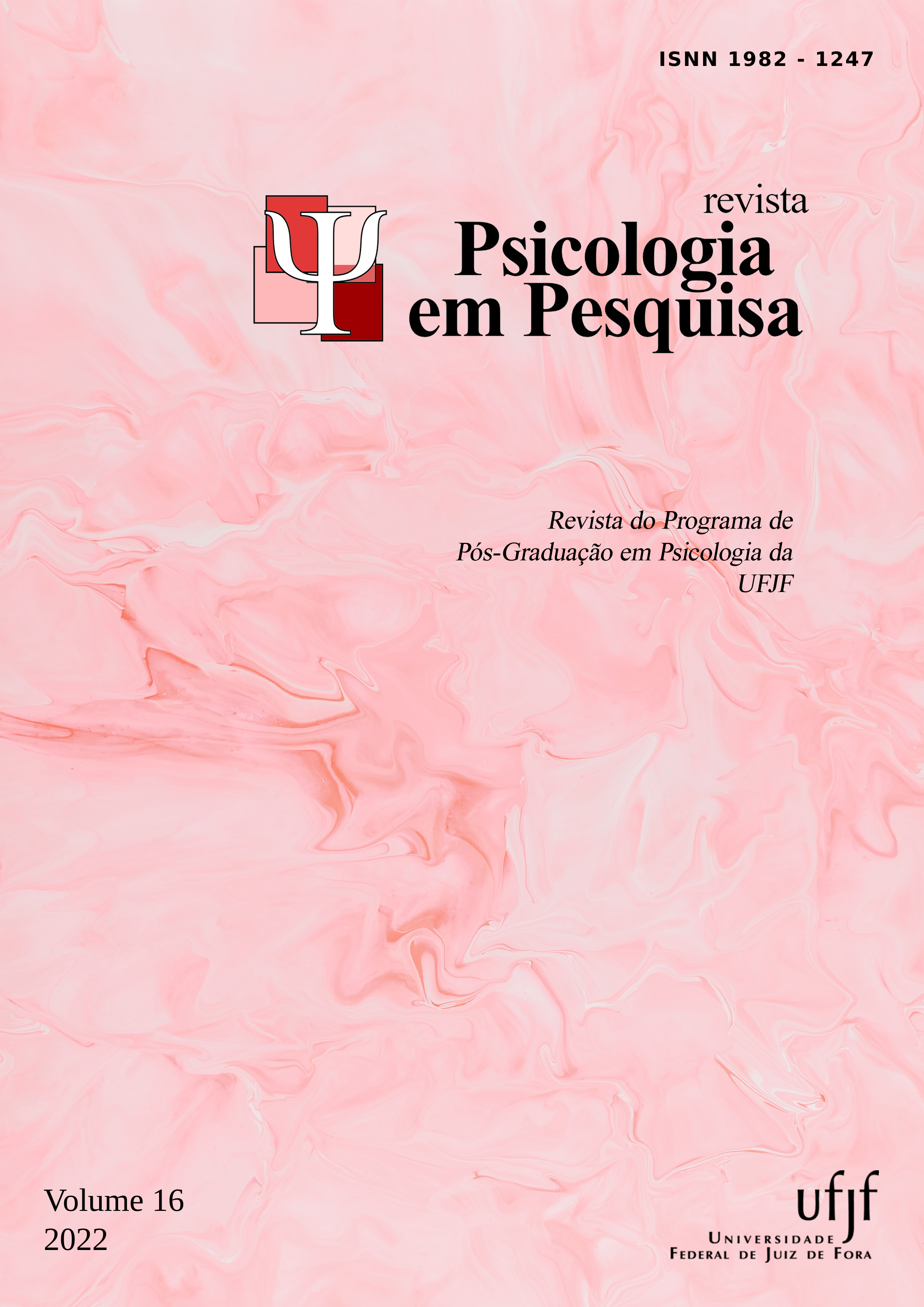Light Triad Scale: Propriedades psicométricas da versão português-brasileira e a relação com aspectos positivos
DOI:
https://doi.org/10.34019/1982-1247.2022.v16.31427Palavras-chave:
Psicologia Positiva, Testes psicológicos, Traços de personalidadeResumo
Esta pesquisa teve como objetivo adaptar a Light Triad Scale para o contexto brasileiro. Foram realizados dois estudos. O primeiro testou evidências de validade baseadas na estrutura interna, e o segundo, as evidências baseadas na relação com outras variáveis. A amostra foi composta por 454 participantes, com idades entre 18 e 64 anos, que responderam a Light Triad Scale, a Escala de Forças de Caráter, a Prosocial Personality Inventory e o Inventário de Competências Emocionais. O instrumento em sua versão brasileira apresentou evidências satisfatórias e demonstrou ser útil para a mensuração de traços positivos de personalidade.
Downloads
Referências
Allport, G. W. (1937). Personality: A Psychological Interpretation. London: Constable.
Asparouhov, T., & Muthén, B. (2009). Exploratory structural equation modeling. Structural Equation Modeling: A Multidisciplinary Journal, 16(3), 397-438. doi:10.1080/10705510903008204
Bueno, J. M. H., Correia, F. M. de L., Abacar, M., Gomes, Y. de A., & Pereira Júnior, F. S. (2015). Competências emocionais: estudo de validação de um instrumento de medida. Revista Avaliação Psicológica, 14(1), 153–163. doi:10.15689/ap.2015.1401.17
Costa Jr., P. T., McCrae, R. R., & Löckenhoff, C. E. (2018). Personality across the life span. Annual Review of Psychology, 70(1), 21.1-21.26. doi:10.1146/annurev-psych-010418-103244
Dann, T. J., Baguley, T., & Brunsden, V. (2014). From alpha to omega: A pratical solution to the pervasive problem of internal consistency estimation. British Journal of Psychology, 105(3), 399-412. doi:10.1111/bjop.12046
Diener, E., & Lucas, R. E. (2019). Personality Traits. In R. Biswas-Diener & E. Diener (Eds), Noba Textbook Series: Psychology. Champaign, IL: DEF Publishers. Recuperado de: https://nobaproject.com/modules/personalitytraits
Gerymski, R., & Krok, D. (2019). Psychometrics properties and validation of the Polish adaptation of the Light Triad Scale. Current Issue in Personality Psychology, 7(4), 341-354. doi:10.5114/cipp.2019.92960
Graziano, W. G., & Eisenberg, N. H. (1997). Agreeableness: A dimension of personality. In R. Hogan, J. Johnson, & S. Briggs (Eds.), Handbook of Personality Psychology (pp. 795-824). San Diego, CA: Academic Press.
Gouveia, V. V., Oliveira, I. C. V., Grangeiro, A. S. M., Monteiro, R. P, & Coelho, G. L. H. (2020). The bright side of the human personality: Evidence of a measure of prosocial traits. Journal of Happiness Studies, 1-22. doi:10.1007/s10902-020-00280-2
Hilbrand, S., Coall, D. A., Meyer, A. H., Gerstorf, D., & Hertwig, R. (2017). A prospective study of associations among helping, health, and longevity. Social Science & Medicine, 187, 109–117. doi:10.1016/j.socscimed.2017.06.035
Hu, L., & Bentler, P. M. (1999). Cutoff criteria for fit indexes in covariance structure analysis: Conventional criteria versus new alternatives. Structural Equation Modeling: A Multidisciplinary Journal, 6(1), 1-55. doi:10.1080/10705519909540118
International Test Commission. (2017). International Test Commission guidelines for translating and adapting tests (Second edition). Recuperado de https://www.intestcom.org/files/guideline_test_adaptation_2ed.pdf
Johnson, L. K. D. (2018). The Light Triad Scale: Developing and validating a preliminary measure of prosocial orientation (Master’s thesis). Available from Electronic Thesis and Dissertation Repository. 5515. https://ir.lib.uwo.ca/etd/5515
Kaufman, S. B., Yaden, D. B., Hyde, E., & Tsukayama, E. (2019). The light vs. dark triad of personality: Contrasting two very different profiles of human nature. Frontiers in Psychology, 10, 1-26. doi:10.3389/fpsyg.2019.00467
Lai, K., & Green, S. B. (2016). The problem with having two watches: Assessment of fit when RMSEA and CFI disagree. Multivariate Behavioral Research, 51(2-3), 220-239. doi:10.1080/00273171.2015.1134306
Moshagen, M., Hilbig, B. E., & Zettler, I. (2018). The dark core of personality. Psychological Review, 125(5), 656–688. doi:10.1037/rev0000111
Muthén, L. K., & Muthén, B. O. (1998-2012). Mplus User’s Guide. Seventh Edition. Los Angeles, CA: Muthén & Muthén.
Neumann, C. S., Kaufman, S. C., ten Brinke, L., Yaden, D. B., Hyde, E., & Tsykayama, E. (2020). Light and dark trait subtypes of human personality – A multi-study person-centered approach. Personality and Individual Differences, 164. doi:10.1016/j.paid.2020.110121
Niemiec, R. M. (2019). Finding the golden mean: The overuse, underuse, and optimal use of character strengths. Counselling Psychology Quarterly, 1–19. doi:10.1080/09515070.2019.1617674
Noronha, A. P. P., & Barbosa, A. J. C. (2016). Escala de Forças de Caráter. Amparo, SP: Universidade São Francisco.
Paulhus, D. L. (2014). Toward a taxonomy of dark personalities. Current Directions in Psychological Science, 23(6), 421–426. doi:10.1177/0963721414547737
Paulhus, D. L., & Williams, K. M. (2002). The dark triad of personality: Narcissism, machiavellianism, and psychopathy. Journal of research in personality, 36(6), 556-563. doi:10.1016/S0092-6566(02)00505-6
Reppold, C. T., Zanini, D. S., Campos, D. C., de Gomes Faria, M. R. V., & Tocchetto, B. S. (2019). Felicidade como produto: Um olhar crítico sobre a ciência da psicologia positiva. Avaliaçao Psicologica, 18(4), 333-342. doi:10.15689/ap.2019.1804.18777.01
Seligman, M. E. P. (2002). Positive Psychology, Positive Prevention and Positive Therapy. In C. Snyder & S. Lopez (Eds.). Handbook of Positive Psychology (pp. 3-9). New York: Oxford.
Seligman, M. E. P., & Csikszentmihalyi, M. (2014). Positive Psychology: An Introduction. In Flow and the Foundations of Positive Psychology (pp. 279-298). Dordrecht: Springer.
The Jamovi Project (2020). jamovi. (Versão 1.2) [Software]. Recuperado de https://www.jamovi.org.















